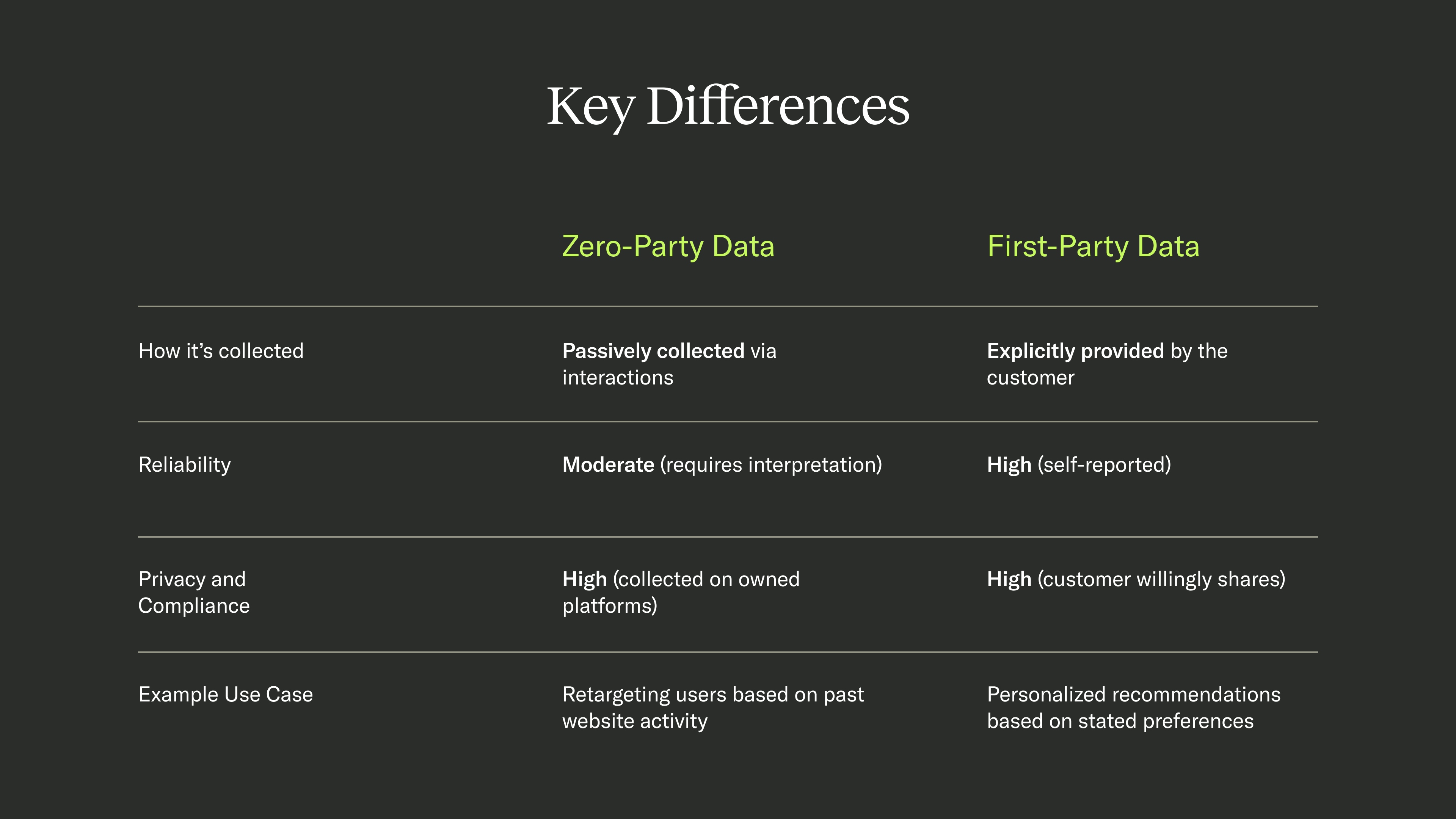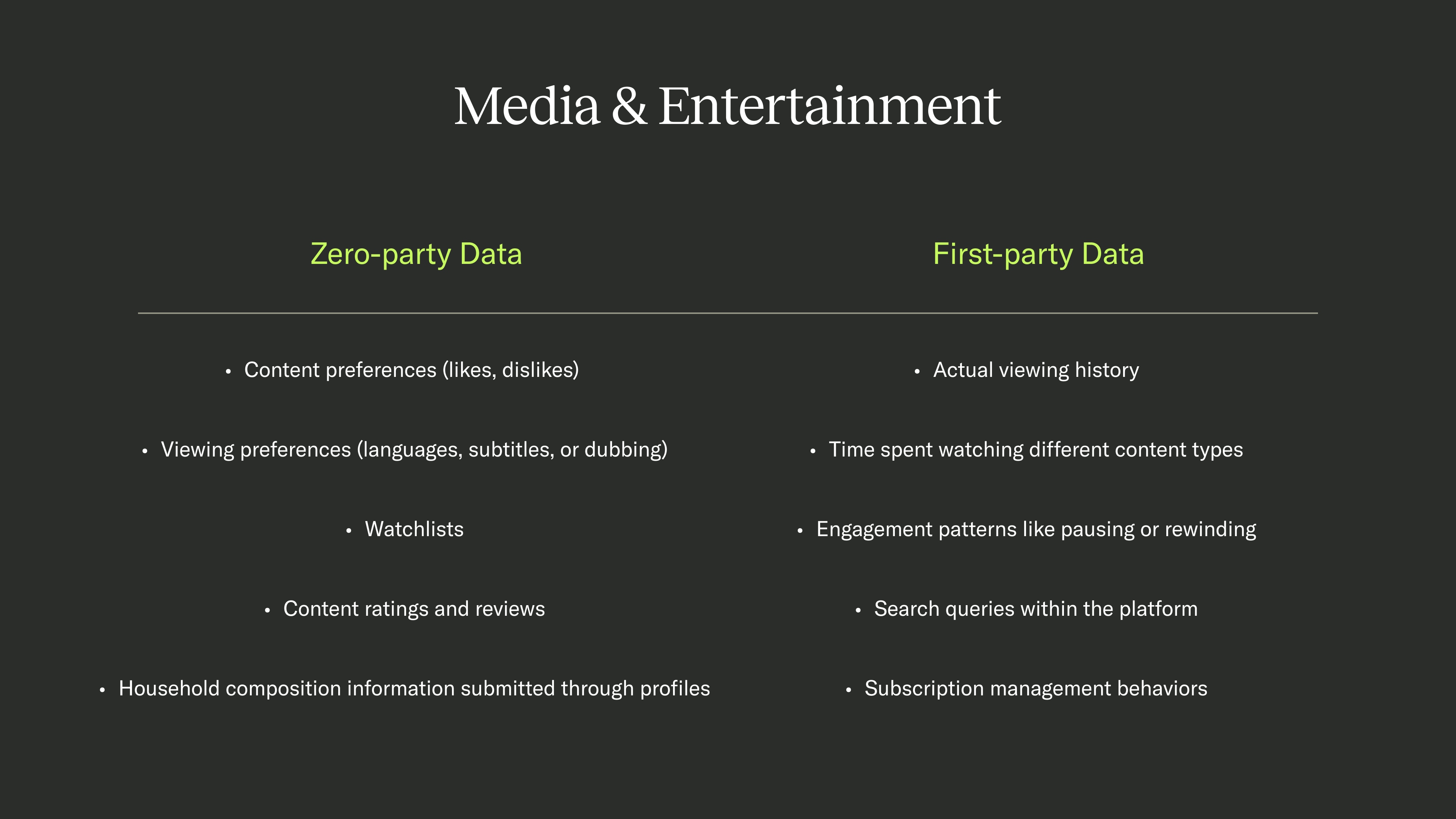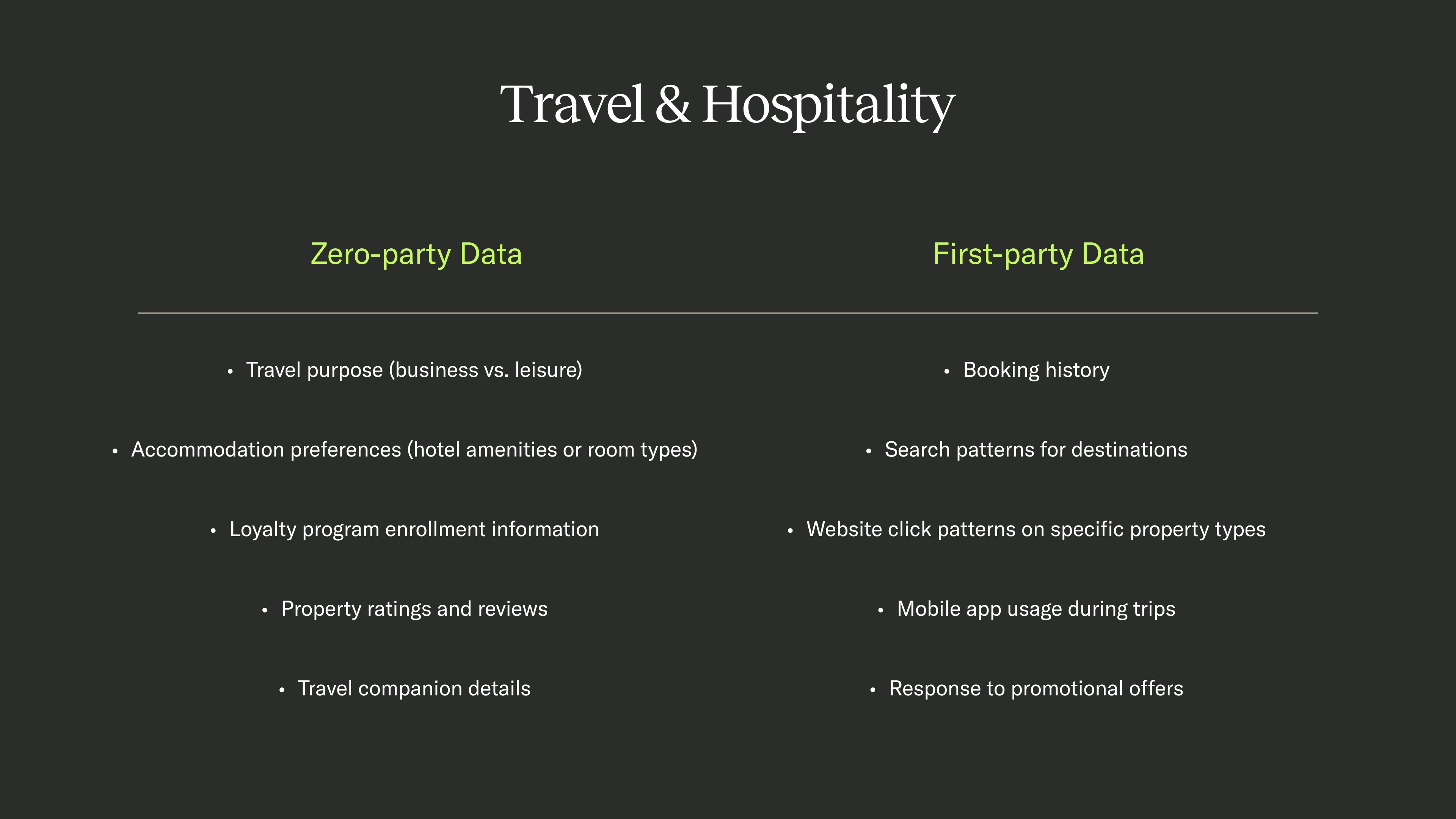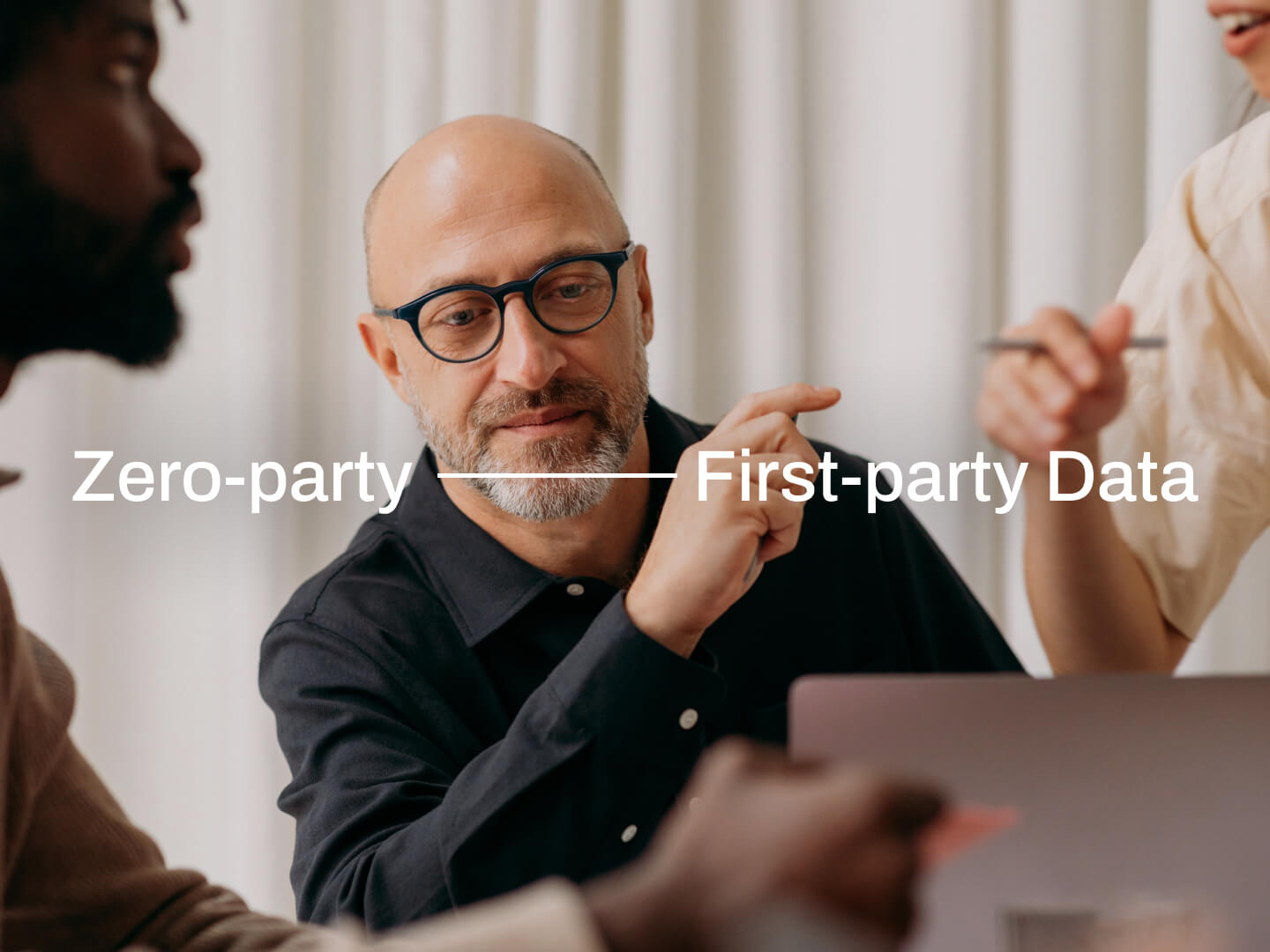The upside of this long wait? Marketers have had time to reprioritize the collection of zero-party and first-party data that creates more direct relationships with consumers. According to EMARKETER, 77% of US marketers already use first-party data as a cookieless solution, while a Forrester study shows that 82% of marketers are collecting zero-party data.
Of course, collection is only the first step. Marketers are finding innovative ways to activate their zero- and first-party data to deliver personalized experiences and create sustained value without the privacy risks of third-party data sources.
The basics: Zero-party vs. first-party data
Zero-party and first-party data are both highly valuable because they come directly from the consumer. The key difference lies in exactly how customers share information with brands.
- Zero-party data is explicitly and intentionally shared by customers, such as through surveys, preference centers, and profile updates.
- First-party data is collected through direct observation of customer behavior across owned channels like websites or mobile apps, such as shopping history or website visits.

The benefits of zero-party vs. first-party data
Unlike data provided by third-party partners and sources, with zero- and first-party data, there’s no need to comb through piles of unspecified data to match information. These data types also offer better control over data governance since you can clearly trace the provenance and permissions of your data.
But there’s more nuance here: Each data type also offers its own unique advantages.
Benefits of zero-party data
With zero-party data, brands can count on:
Higher confidence in data accuracy: The information comes straight from the customer, reducing the risk of misinterpretation that often occurs with inferred data. For example, consider a banking customer who indicates they’re interested in retirement planning and college savings. You can use this zero-party data point to confidently target the customer with relevant offers, rather than making assumptions based on demographics and missing potential upsell opportunities.
Stronger foundation for trust and transparency: Consumers are increasingly aware of privacy laws and concerned with how companies use and protect their personal information, with 75% of consumers saying they won’t purchase from organizations they don’t trust with their data. With zero-party data, consumers know what they’ve shared, and any personalization based on that information feels welcome and expected rather than intrusive.
Clear consent and privacy compliance: Zero-party data collection typically happens within a consent framework, making it easier to demonstrate compliance with regulations like GDPR and CCPA.
Benefits of first-party data
First-party data provides its own unique advantages, with brands receiving:
Real behavioral insights that may differ from stated preferences: First-party data reports what customers actually do, not just what they say. For example, a streaming subscriber might rate documentaries and foreign films highly in their profile but spend 80% of their viewing time on reality TV shows—a valuable insight for prioritizing new episode notifications.
Continuous updates based on customer interactions: Every customer interaction refreshes first-party data, creating a dynamic picture of changing customer needs and interests. Unlike static profile information that quickly becomes outdated, behavioral data shows when a loyal skincare customer suddenly starts browsing prenatal products, signaling a life change that creates new marketing opportunities.
Detailed engagement patterns: First-party data reveals how customers interact with specific content across their journey, from initial awareness to consideration and purchase. Media companies can track which topics keep readers engaged longest, which stories drive subscription renewals, and which content formats (video, interactive, or long-form) are most often shared.
Scalable data collection: Automated data collection delivers comprehensive insights without requiring explicit customer action. Passively collecting first-party data means you’re gathering valuable intel even from consumers who never fill out a survey or update their preferences, creating a more complete picture of your entire customer base as opposed to your most engaged segments.
Zero- and first-party data makes it easier to understand the consumer while building trust and stronger relationships, which can increase lifetime value.
Examples of zero-party vs. first-party data
Let’s get into specifics and explore how zero-party and first-party data collection can happen across different industries.

Media and entertainment
Zero-party data
- Content preferences (likes, dislikes)
- Viewing preferences (languages, subtitles, or dubbing)
- Watchlists
- Content ratings and reviews
- Household composition information submitted through profiles
First-party data
- Actual viewing history
- Time spent watching different content types
- Engagement patterns like pausing or rewinding
- Search queries within the platform
- Subscription management behaviors

Retail
Zero-party data
- Style quiz responses
- Size information shared in profiles
- Occasion-based preferences ("I'm shopping for a gift")
- Wishlist items
- Product reviews
First-party data
- Browsing behavior across categories
- Purchase history
- Cart abandonment patterns
- Response to promotional content
- In-store purchase data connected to loyalty accounts

Travel and hospitality
Zero-party data
- Travel purpose (business vs. leisure)
- Accommodation preferences (hotel amenities or room types)
- Loyalty program enrollment information
- Property ratings and reviews
- Travel companion details
First-party data
- Booking history
- Search patterns for destinations
- Website click patterns on specific property types
- Mobile app usage during trips
- Response to promotional offers
Across industries, zero-party data delivers explicit customer intentions and preferences that add clarity and build trust, while first-party data provides behavioral insights that reveal actual customer actions and engagement patterns. The former tells you what customers say they want; the latter shows what they actually do.
Understanding zero-party data, first-party data, and the relationship between them is crucial for delivering meaningful personalization that balances customer aspirations with their real-world behaviors.
The future of zero-party vs. first-party data: Creating enhanced value
Collecting this data is just the first step. Modern customer data platforms (CDPs) enable marketing teams to go beyond collection and storage by transforming zero- and first-party data through integrated intelligence.
By combining zero-party and first-party signals in a CDP, organizations can validate customer preferences against actual behavior, improving accuracy in personalization and targeting. Layering in AI-powered predictions about customers’ likely interests allows teams to further fill in the gaps in customer profiles.
Tatcha’s perfect blend of zero- and first-party data
Tatcha, a luxury skincare brand, exemplifies this approach in action. They gather zero-party data directly from customers who share their preferences and skincare needs while also leveraging first-party insights from digital interactions and purchase behaviors. Using Cortex, mParticle's AI/ML engine, Tatcha identifies high-propensity audiences for campaigns, such as those most likely to complete the quiz or subscribe to auto-delivery programs, which enables precise audience segmentation and drives significant gains in engagement, conversion rates, and revenue.
This type of enrichment and activation allows organizations to:
- Resolve differences between stated preferences and observed behavior
- Create more accurate predictive segments
- Adjust personalization in real time based on both data types
- Enhance the value of customer data at each step
Implementation examples: How marketers can use zero-party and first-party data together
Putting the pieces together, here are a few examples of how organizations across industries can activate zero- and first-party data.
Media companies can deliver content recommendations that balance declared interests with engagement patterns. When a user indicates they enjoy documentaries but their viewing history shows they primarily watch short-form content under 30 minutes, a streaming service might prioritize documentary series with shorter episodes rather than feature-length films.
Retailers may personalize product discovery using both style quiz responses and browsing behavior. When a customer indicates they prefer sustainable products but consistently browses mid-price items, a retailer might highlight affordable eco-friendly options rather than premium products that don't match the customer's actual buying patterns.
Travel brands can optimize loyalty programs by combining stated preferences with actual booking patterns. A traveler who indicates interest in adventurous destinations but consistently books beach resorts might receive content about adventure activities available at beachfront properties.
Beyond collection to continuous value creation
In a post-cookie world, focusing on zero- and first-party data creates a fundamentally better outcome: a customer understanding built on direct relationships, explicit consent, and balanced interpretation of what customers say versus what they do.
By combining zero-party and first-party data through integrated intelligence, marketing teams can create more personalized experiences while maintaining trust and transparency.




.jpg)
.jpg)
.jpg)
.jpg)
.webp)
.webp)